A few weeks ago I was in a bad place.
My product Pegasus—a Django boilerplate for SaaS applications—was having its worst sales slump in recent history. Meanwhile, my other product, Place Card Me—an online place card maker—continued to be hit hard by the pandemic, with sales down almost $10,000 from 2019. It looked like I was going to fall short on my targets for the month. Again.
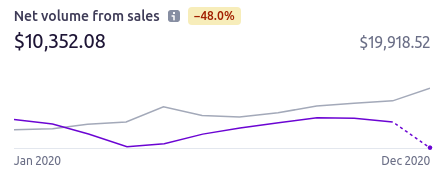
The grey line is Place Card Me’s profits in 2019. The purple line is 2020. Thanks, Covid.
And then on a lark I thought, “well maybe I’ll try running a Black Friday sale.”
And my month’s trajectory completely changed.
A few hours of work and a week later, and I had shattered my previous earnings for any month—earning more than 3 months’ worth of typical profit in a single week.
Through the process, I learned a lot about running sales—lessons I thought I should share. Because Black Friday is a huge opportunity for online creators and indie hackers. One that—if you’re anything like me—you’re probably not taking full advantage of.
Here’s what I did and what I learned along the way.
Deciding to run a sale by overcoming the “ickiness factor”
If you’re like me, your first reaction to the idea of a Black Friday sale might be something along the lines of “ugh, those are so overdone and spammy”. And it’s true, Black Friday and Cyber Monday sales have become ubiquitous online.
But Black Friday sales aren’t inherently bad.
Many consumers, including myself, happily take place in Black Friday deals. They’re a great way to support creators and pick up products you’ve long considered buying.
To get over my fear of “Black Friday ickiness”, I decided to turn to other successful creators who were also running deals. Adam Wathan and Steve Shoger of Tailwind UI / Refactoring UI; online educator extraordinaire Wes Bos; fellow solopreneur Mike Lynch for his product TinyPilot. How were they doing Black Friday and what could I learn from them?
My favorite example came from Wes Bos, which Harry’s Marketing Examples did a great job analyzing:
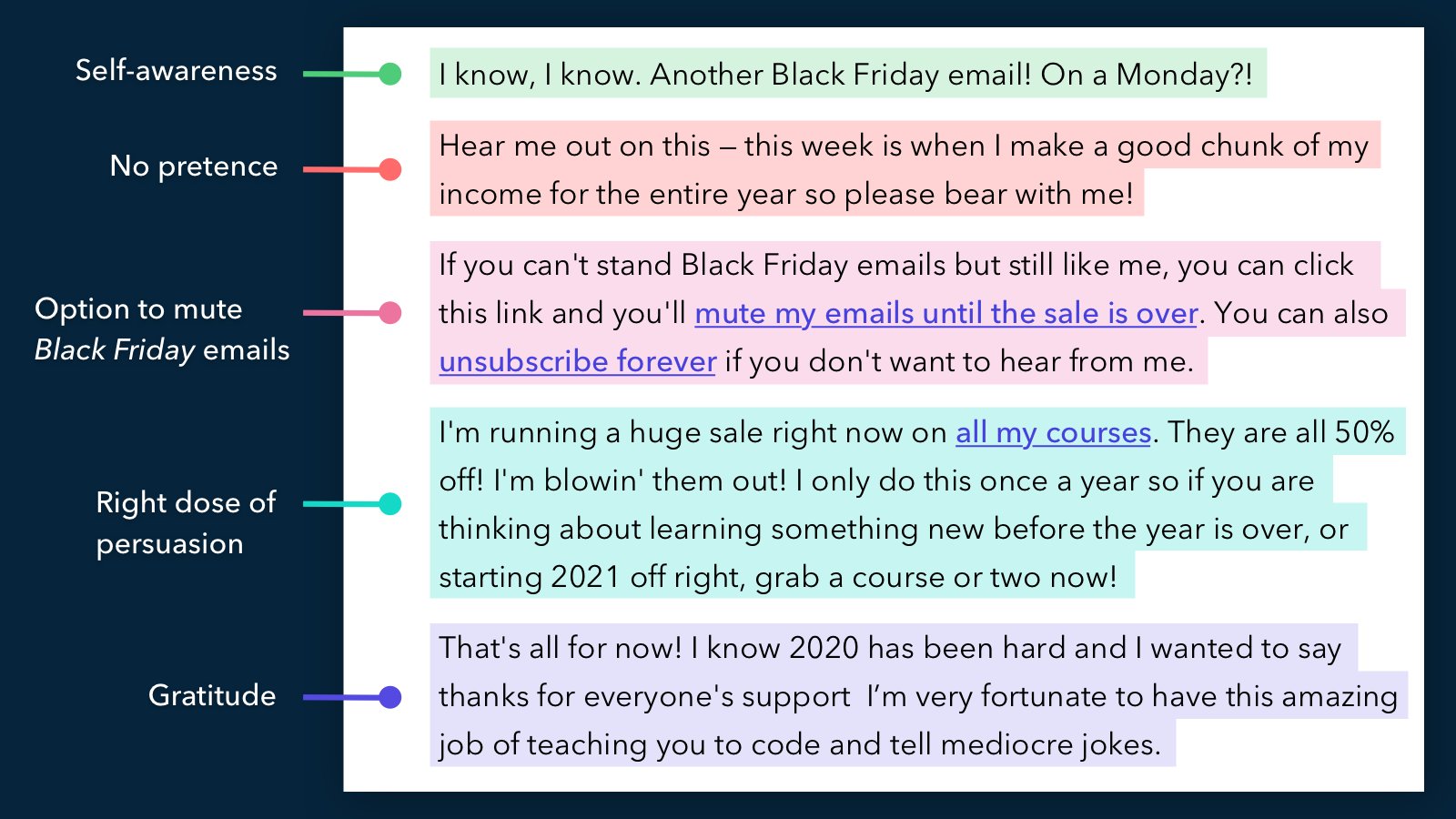
Wes Bos’s “masterful” Black Friday email. Image and analysis from Harry’s Marketing Examples
This email and the others I looked at all shared similar qualities. They were genuine, they put the reader first, and they weren’t too pushy. It was “hey, here’s a great deal in case you’re interested, if not, sorry to bug you.”
Seeing that it was possible to run a deal in a classy way was enough to get me over the “ickiness” factor, and provided a framework for crafting my own sales communications.
Lesson: Running a sale doesn’t have to be “icky” if you do it right.
Choosing the right sale structure by adding value
People expect Black Friday deals to offer a huge discount from normal prices—particularly for online products. Here’s a typical deal I received, with bundle of fonts being offered at 95% off the normal price:
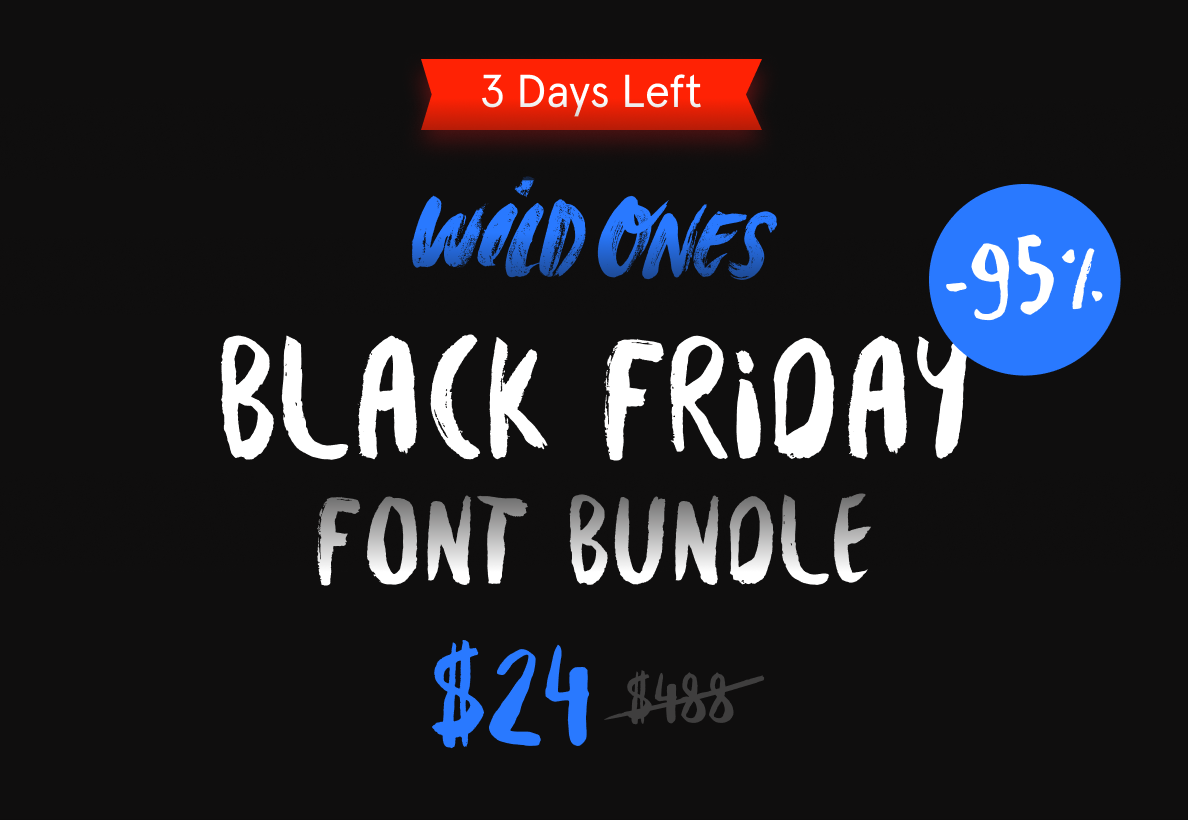
A typical Black Friday deal—offering 95%-off a bundle of commercial fonts.
Offering a huge discount is a great way to drive sales, but it comes with a huge cost. Literally. A big discount will substantially reduce your revenue-per-customer and leave money on the table.
And that’s not the only problem.
In addition to the lost revenue, massive discounts devalue your product. If your customers know that you sometimes sell your product for 95% off, they’re likely to think it’s only worth 5% of it’s price. You’ve just turned your valuable good into a commodity.
So how do you run a sale without reducing your prices? You add value.
Take Adam Wathan and Steve Shoger’s deal. They took their two products, Tailwind UI (normally $249) and Refactoring UI (normally $149), and bundled them together for $279. Their customers are simultaneously saving $120 while paying more than the price of either individual product. This is adding value at its finest.
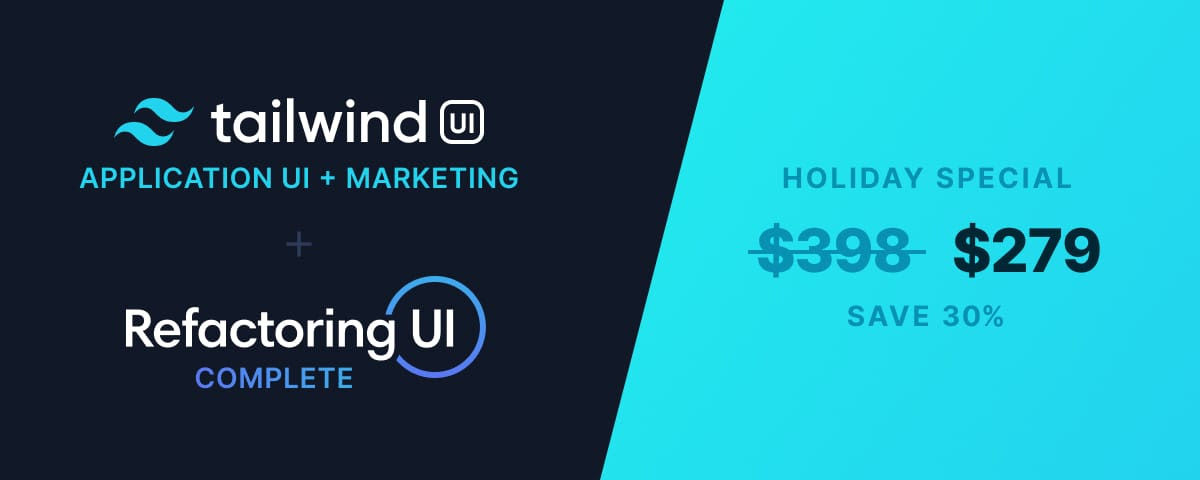
The Tailwind UI / Refactoring UI deal—which used bundling to offer 30% off while simultaneously increasing prices.
Bundling—what Adam and Steve did by offering two products together at a discount—is a great way to add value while not lowering prices. A similar approach is to offer increased benefits on a lower pricing tier. This is the approach I took with my own product.
My product, SaaS Pegasus, is designed to help people launch new web applications quickly. Pegasus has two pricing tiers, a single-site version for $295, and an unlimited version for $750. The product is the same, but the single-site version is only able to be used on—well—a single site, while the unlimited version can be used on—you guessed it—unlimited sites. The unlimited version also comes with lifetime updates to Pegasus itself, instead of just a year.
Anyway, the details aren’t important, but what is important is that more than 90% of my customers opt—at least initially—for single-site. So for my Black Friday deal I decided to offer the unlimited version at price of single-site. This allowed me to offer a 60% discount without significantly reducing my revenue per customer or devaluing my product.
Whether you use bundling, the “increased benefits on a lower tier” approach, or something else, adding value is a great way to create a “Black Friday deal” feeling while not incurring some of the financial and psychological costs associated with heavy discounting.
Lesson: Don’t lower prices, add value.
Promoting the sale to the world
Ok, you’ve gotten over the ickiness factor and you’ve chosen a sale structure that adds value. Now’s the most important part: spreading the word.
When considering how best to get the word out, think of the following breakdown. Everyone is either interested or not interested in your sale. Likewise everyone will either find out or not find out about it. This creates four buckets that any person might fall into:

Breakdown of the possible ways people can experience your sale.
The two green boxes are what you’re aiming for. Of course, you want everyone who might be interested in the sale to find out about it—these are your potential customers! Also, you want everyone who isn’t interested in the sale to not get spammed by it—the blissfully unaware.
The tradeoffs and mistakes happen in the red boxes. What you really want to prevent is lost customers—people who would have been interested in the deal but never knew it was happening. You also want to annoy as few people as possible, but it’s generally better to promote the deal to someone who wasn’t interested than to have someone who was interested miss it. The upside of a potential sale clearly outweighs the downside of mildly annoying someone.
Lesson: Default to promoting everywhere that the signal-to-noise ratio isn’t terrible.
Where to promote your sale
The key avenues for promotion—in order of importance—are your website, your email list, and other online marketing channels.
Your website is your best source of potential customers.
No one is more likely to be interested in your deal than someone who is already browsing your product website, so you should do everything you can to ensure all website visitors see your deal.
I used the common technique of splashing a big-ass colorful banner on every page of the site. Here’s what it looked like.
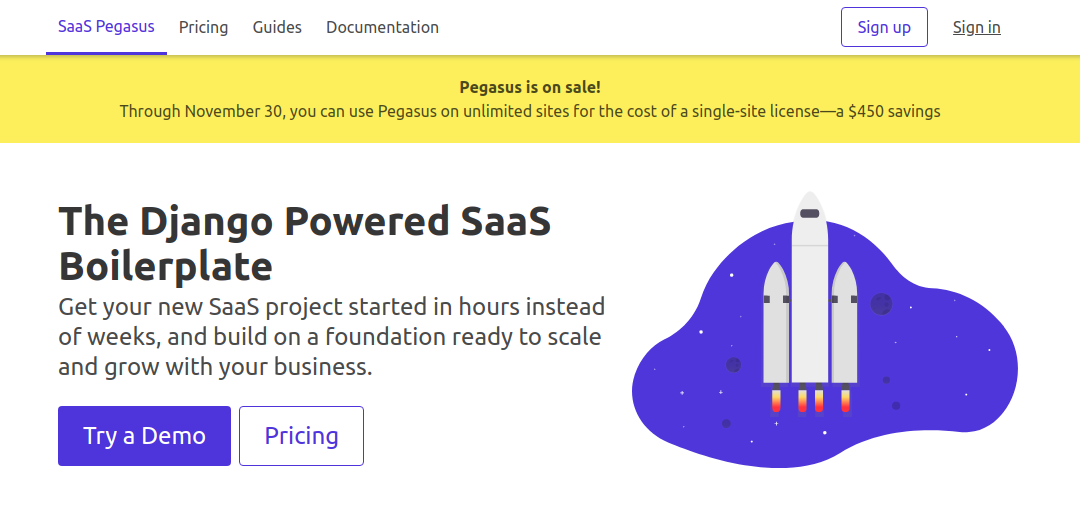
Don’t be shy promoting your sale on your website. These are the people most likely to benefit from it.
Your goal is to make it impossible for someone visiting your website to not hear of the sale, so err on the side of flashy, even if it seems a bit much.
Your email list is your next best source of potential customers.
People on your email list were interested in your product at one point, and so are more likely than almost anyone else to still be interested, so make sure to let them know!
My email sequence consisted of two mails:
- An email at the start of the sale telling people about it.
- An email with 24 hours left in the sale telling people it was about to end.
Some people add a third email in the middle—often with 48 hours to go. I don’t recommend more than 3 emails as you seriously risk pushing people further into the “annoyed” category.
In terms of email copy—you can’t do better than the Wes Bos example above. But for the sake of transparency, here’s the mail I used:
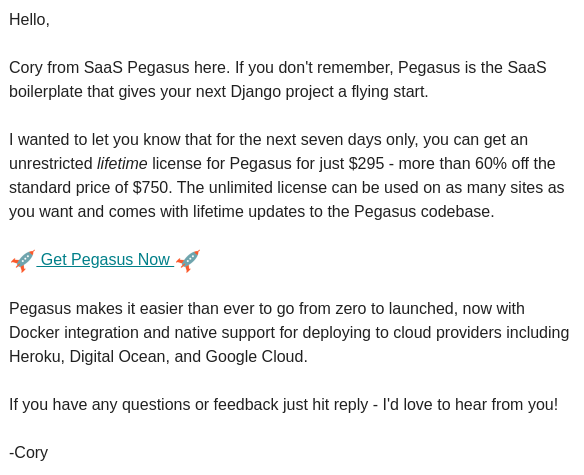
The first email in my sequence announcing the Pegasus Black Friday deal.
One difference between Wes and I is that my email list is cold—I almost never use it. So I added a reminder for people who might be wondering what Pegasus even was. I also included details on some new features to show that I’m still improving the product.
All other channels besides your website and email list are a distant third in terms of usefulness.
For this reason, I severely limited promotion in other places unless they were specifically aggregating Black Friday deals—and therefore unlikely to annoy anyone.
Depending on your product and audience, social media can be a good channel, though it’s not for Pegasus so I didn’t bother promoting there.1
Driving extra traffic during the sale
It’s important to realize that unless you did something very wrong, people will be more likely to purchase your product during a sale than at any other time.
Now, if you’ve taken the advice above and are still getting good revenue-per-customer during the sale, there is an interesting side-effect: website traffic during a sale is more valuable than at any other time.
I’ll show you just how much more valuable it was for me in the next section (preview: it was way more than I expected).
In practice, this means that any additional effort you can expend to get people to your website—for any reason—will have a higher payoff during a sale.
How you leverage this information depends on your marketing strategy. If you’re running ads, consider increasing your budget while the sale is running; if you do content marketing, consider publishing your next big article during the sale, etc. These efforts—while not necessarily directly related to the sale—will have the side-effect of getting more eyes on your site at the exact moment your conversion rate is highest. Meaning more money for you.
Here I just got lucky.
I happened to notice the same day my sale started that my conference talk “Modern JavaScript for Python Developers” had recently been released, so I decided to promote it a bit, thinking it might generate some fallout traffic to the site. The topic of the talk is relevant to my potential customers, who are mostly Python developers.
Among other things, it ended up being the top post on the Django subreddit for the entire month. This had a snowball effect of getting shared in other relevant places, and generally served to drive a fair amount of “bonus” traffic to my site during the sale.
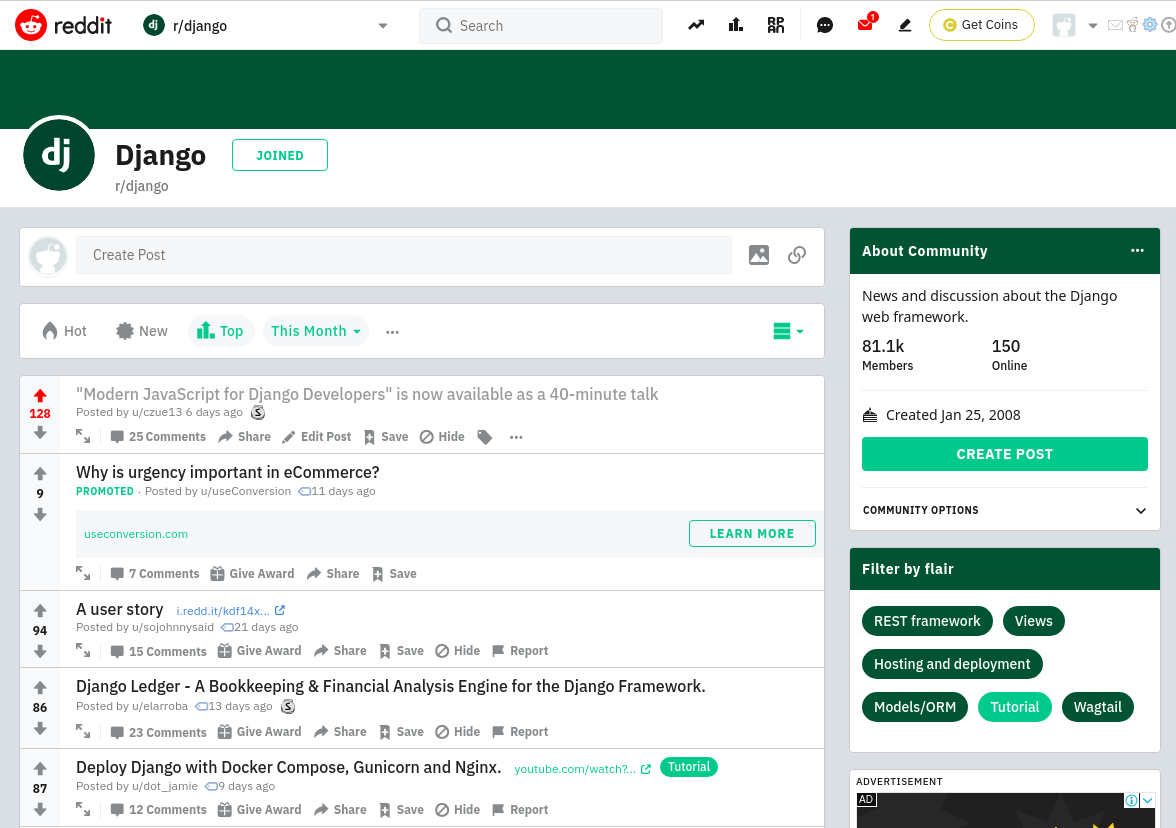
A conference talk based on my Django JavaScript Guide was the #1 article on /r/django for the month of November.
This happy coincidence probably earned me hundreds, possibly thousands, of dollars. I’ll definitely plan my next sale around some kind of similar content marketing push.
Lesson: Try to time additional marketing pushes for when you have a sale running.
Cashing in
After you do your promotion you’re in for the fun part: the payout!
Now I can’t say much about what you should expect to earn. This make will depend on many factors, including your product, sale pricing, audience size, and of course, luck.
What I can say, is that I made a lot more than I expected to. More than three months worth of typical profit in a single week.

My Pegasus profits by week for the last six months.
Here are full the details:
| Days running | 7 |
| Total sales | 21 |
| Total revenue | $6,195 |
| Total profit | $6,002 |
| Conversion rate from email outreach | 0.8% (7 sales) |
| Conversion rate from new sign ups | 16% (14 sales) |
The last two numbers were the ones that blew my mind.
If you created an account while the sale was running you were almost 20 times more likely to purchase than if you created an account before the sale started.2
These two groups of people are the exact same from a behavior perspective—they all signed up to try my product. The only thing that separates them is when they did it.
This ratio was bonkers to me, and makes me want to run more experiments targeting people immediately after they sign up.
The importance of choosing the right thing to work on
This whole experience has reinforced a lesson that I’ve had to learn and re-learn over and over again throughout my career. That lesson is on the importance of choosing the right thing to work on.
It doesn’t matter how fast you move if it’s in a worthless direction.
Picking the right thing to work on is the most important element of productivity and usually almost ignored. So think about it more! Sam Altman, Productivity
I chose to run a Black Friday sale on a whim. I could have continued coding the next feature, writing a blog, or doing any number of other things and easily lost out on thousands of dollars.
Ultimately the snap decision to spend a few hours of time doing a Black Friday deal had a larger impact on my business than any other single thing I’ve done in the last year.
Which has me thinking about all the other ways I’m probably not working on the “right” thing. I don’t have all the answers, but I am trying to apply this lesson where I can to my businesses.
I’m inspired by people like Reilly Chase, who has managed to mostly-bootstrap his company Hostifi to over $500k in revenue by focusing on what matters. What was that? Well, certainly not the code.
Today I'm open sourcing the code that I've made $500K off of: https://t.co/8HgUdw1DjK pic.twitter.com/KiIcNVtMEt
— Reilly Chase☁️☁️☁️ (@_rchase_) December 3, 2020
Reilly Chase’s business is a 3,000-line Python file earning $500k a year.
I—like many developer/indie hackers—can spend hours, weeks, even months refactoring a codebase, trying out hot new JavaScript and CSS frameworks, and generally working on things that don’t have a material impact on the bottom line.
This experience—like Reilly’s tweet—has been a good reminder to focus more, or at least some, on activities that focus more on the bottom line of my business. Even if they sound boring or icky at first.
I encourage you to do the same.
Lesson: Choose carefully what you decide to work on.
That’s it!
If you enjoyed this write up you might want to follow me on twitter or subscribe for email updates below where I post monthly updates on my businesses.
Notes:
-
Now with the benefit of hindsight I wish I had promoted more on social media. I likely over-optimized for “not annoying” and may have lost out on a sale or two as a result. Next time. ↩
-
This number is probably slightly misleading due to emails not being opened, people already having purchased, etc. But in terms of order of magnitude it’s still a very stark contrast. ↩